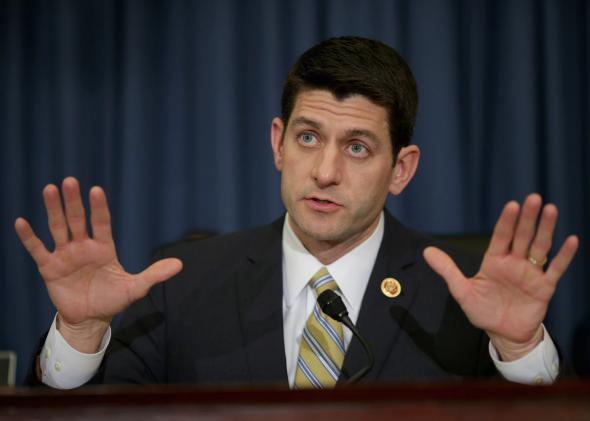Paul Ryan’s budgets always involve a little sleight of hand. In past years, for instance, he’s outlined elaborate plans for cutting taxes, without explaining how he actually planned to pay for them in order to close the deficit.
Today, Ryan’s House Budget Committee is out with its latest spending blueprint. As usual, it’s largely an orgy of cuts to safety net programs like Medicaid and food stamps. It would also dismantle the Affordable Care Act, because of course. And it would supposedly eliminate the deficit in about 10 years.
So what makes this conservative fantasy budget different from all other conservative fantasy budgets? A new accounting gimmick—this time in the form of miraculous economic growth. The Wall Street Journal explains:
[T]he budget includes a new line item that didn’t exist in his past proposals, which Mr. Ryan has labeled “macroeconomic fiscal impact” and which he says would further reduce the deficit by $74 billion [in 2024]. This would result in a $5 billion net surplus.
Building in assumptions about economic growth is a controversial part of budget math, and Mr. Ryan didn’t include the same assumptions in prior proposals. This sort of analysis is popular with Republicans, who often cite it in proposals to cut taxes. Steve Bell, a former top Senate budget aide now with the Bipartisan Policy Center, called Mr. Ryan’s move “unconventional,” but wouldn’t expound further.
This is what’s known as “dynamic scoring,” and the GOP tends to use it as a quick fix in budgeting the same way Chinese takeout joints deploy MSG to flavor your lo mein. Much as Republicans argue that tax cuts actually pay for themselves in part by boosting growth and IRS collections, Ryan’s new budget assumes that cutting the deficit would plump the economy by lowering interest rates and making it easier for the private sector to invest. More growth, in turn, would help close the deficit by creating jobs and tax revenue.
To Ryan’s credit, this is only partially a flight of fancy. His math relies in part on relatively mainstream estimates by the Congressional Budget Office. But the CBO isn’t an oracle, and much as the connection between tax rates and growth is controversial, so is the exact relationship between federal spending, interest rates, and private investment. And much of it is highly dependent on the exact state of the economy and the mood of the Federal Reserve.
Nobody really has the predictive powers to foresee all those moving variables 10 years out. So when Ryan says that dramatically cutting the budget will spur X amount of growth, to some degree he’s just picking a number out of a hat, while conveniently ignoring the possibility that slashing the welfare state might have some negative macroeconomic affects of their own. People need money to spend on food, after all.
